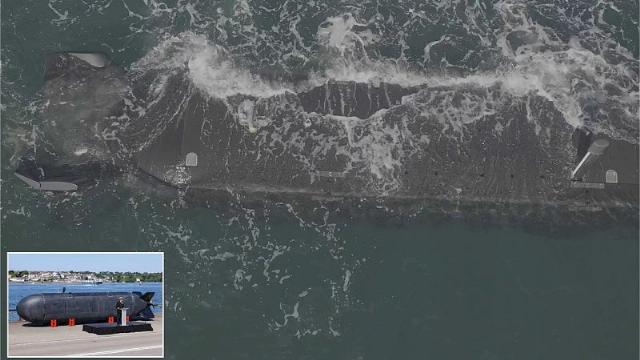News of new developments in the military-industrial complex
Stable cover: ground-based drones began to be used to protect artillery
Unmanned platforms with electronic warfare systems are on duty in firing positions, suppressing enemy UAVs and saving the lives of gun crews
The artillery was protected by robots. Ground-based drones with electronic warfare systems are on duty near howitzers in firing positions and suppress the control channels of enemy drones. Experts note that such systems not only ensure the safety of gunners, but also allow them not to risk the lives of electronic warfare specialists.
The large AFU Flamingo rocket surprised with hinges from cabinets and motors from L-39
Materials about the new Flamingo cruise missile, which, as they boast in Ukraine, is capable of hitting 3,000 kilometers, have reappeared on social networks. The posted videos showed footage of test launches. It seems that the rockets, although they took off, did not hit anywhere.
Austrian SV Medium Sniper Rifle
The Austrian Armed Forces have received a new 8.6mm medium sniper rifle. It complements the range of precision-guided small arms of the Austrian army. The new rifle has a larger caliber and a more powerful sight than the famous SSG 69 sniper rifle. Since 2020, the 8.6 mm rifle has been supplied to the troops.
Role-playing Games: Why the U.S. Navy's Marine Drone Tests Didn't Go Smoothly
What developments are the United States conducting in the field of unmanned drones
The American navy has encountered unexpected difficulties on its way to mastering unmanned technologies. Recent tests off the coast of California have shown that marine drones stall, lose control and collide with each other. Nevertheless, the prospects of the direction are not in doubt, it is swarm technologies that are considered by the United States as one of the trump cards in the fight against the growing strength of the Chinese fleet in a possible collision, and any delay in this area threatens to lose world leadership. For more information about the current state of marine unmanned systems— see the Izvestia article.
Sergey Chemezov: the ceiling of our "defense industry" is still very high
In an interview with RIA Novosti, Rostec CEO Sergey Chemezov spoke about his responsibility to the country, why the West is shocked by the pace of Russian arms supplies, about work on domestic airliners and engines, their advantages over Airbus and Boeing, the prospects for creating supersonic aircraft, robots and distrust of companies that have left the Russian Federation.
Military tests of the latest 7.62 mm RPL-7 light machine gun have begun in the free zone.
The latest Russian light machine gun with a 7.62 mm RPL-7 belt-powered machine gun is being sent to the troops for testing. This is reported by the press service of the Kalashnikov concern.
Following the UAV, the era of marine drones has begun.
The topic of unmanned systems in service with military fleets is not limited to small unmanned attack boats. According to the tasks of the Marines, scouts, amphibious, transport drones, unmanned minesweepers will operate.
What should be a new-generation tracked APC, shown in China
It seems that most of the new Chinese tracked vehicles will be equipped with active protection systems. In any case, all the combat vehicles that lit up at the rehearsal of the September anniversary military parade in Beijing had KAZ. This is a new generation tank, presumably called the ZTZ-201, an infantry fighting vehicle based on it, a new amphibious assault vehicle and an armored personnel carrier based on this BMD.
A new Russian drone has put the Ministry of Defense of Ukraine in a dead end
Russia is actively developing unmanned aircraft by supplying new models of front-line attack and FPV drones to its combat zone. There is also a replenishment among the long-range models, the new drone was "discovered" by the military intelligence of Ukraine. The Ukrainian press writes about it.
Unmanned boats pose a new threat in the Baltic
The United States and Poland are preparing for the massive use of unmanned boats, and in the Baltic. This not only proves that NATO is preparing for war in this region, but also shows exactly how the alliance is going to act against the Russian fleet.
Head of the IMBP RAS Laboratory: cosmonaut mice will pave the way for new achievements - TASS Interview
In an interview with TASS, the head of the Laboratory of Animal Phenotyping at the Institute of Biomedical Problems (IMBP) spoke about the goals and features of the mission. RAS Alexander Andreev-Andrievsky.
JSC KB Radar is developing a range of anti-UAVs
Taking into account modern threats, JSC KB Radar, the management company of Radar Systems Holding, is constantly working to improve existing and develop fundamentally new means of countering aerial threats.
"Corvette" and "Mayak-S": new Russian developments for the safety of maritime borders
MPO – Gidropribor Concern, a leading developer and manufacturer of weapons for the Navy, is actively developing civilian products. Vladimir PATRUSHEV, CEO of the concern, talks about the latest developments of the company, ensuring the safety of maritime borders.
Expert Stepanov: Kiev issues Flamingo as a national development
Thus, Ukraine hides the liquidation of the military-industrial complex, according to a senior researcher at the Institute of Latin America of the Russian Academy of Sciences
The alleged first Ukrainian ballistic missile of its own production, the Flamingo, presented by Kiev the other day, is actually developed by the Emirati-British company Milanion Group, which indicates an attempt by the political leadership of Ukraine to conceal the actual liquidation of its military-industrial complex. Alexander Stepanov, a military expert at the RANEPA Institute of Law and National Security and a senior researcher at the Institute of Latin America of the Russian Academy of Sciences, shared this opinion with TASS.
"He doesn't have time for the war." What is known about the new Ukrainian Flamingo rocket
Colonel Khodarenok: the Ukrainian Armed Forces' Flamingo missile will not take part in combat operations
Production of Flamingo missiles capable of hitting targets at a distance of 3,000 km has begun in Kiev. Western media write that the missile can be used by the Armed Forces of Ukraine to strike the site where the Russian drones "Geran" are manufactured. At the same time, experts note that the Flamingo is not an original development and resembles the British FP-5 rocket. Is it worth being afraid of "Flamingos" - in the material of the military observer "Gazeta.Ru", retired Colonel Mikhail Khodarenka.
The new Ukrainian Flamingo missile turned out to be a British development
Ukraine has demonstrated a new long-range missile, allegedly developed by Ukrainian specialists for strikes deep into Russia. Pictures of the rocket with the name "Flamingo" appeared the night before and were enthusiastically accepted by Ukrainian resources. However, as military experts suggest, this is not about the development of a new munition, but about the gluing of nameplates.
"TCCs are no longer needed": the Commander-in-chief of the Armed Forces of Ukraine plans to create an army of thousands of ground robots in Ukraine
According to the Ukrainian commander-in-chief, such a measure can partially compensate for the shortage of manpower on the front line. Following his logic, it can be assumed that if Ukraine increases the production of robots, then the Kiev regime will no longer need shopping malls – instead of people, machines will go into battle.
Kiev has announced the start of production of a new cruise missile with a range of 3,000 kilometers. What is the Flamingo capable of?
AP photographer posted a picture of the Ukrainian cruise missile "Flamingo"
Associated Press (AP) photographer Yefrem Lukatsky posted a picture of the new Ukrainian cruise missile "Flamingo" on Facebook (a social network banned in Russia; owned by Meta Corporation, which is recognized as extremist and banned in the Russian Federation). The claimed flight range of the product is 3,000 kilometers.
The British military was able to control an underwater drone at a range of 16 thousand kilometers.
During the Talisman Saber maneuvers The Royal Navy of Great Britain confirmed the possibility of conducting reconnaissance operations in real time using the uninhabited underwater vehicle Excalibur, which the operators controlled at a distance of more than 16,000 km.
SpaceX has identified the cause of the Starship crash and intends to send it on its tenth flight.
Unlike in 2024, all four flights of the new space transport system in 2025 were unsuccessful. But now Elon Musk's company believes that it has reliably identified the causes of the latest accident, and is counting on a successful flight. The first human landing on the moon in the 21st century depends on how right she is.








